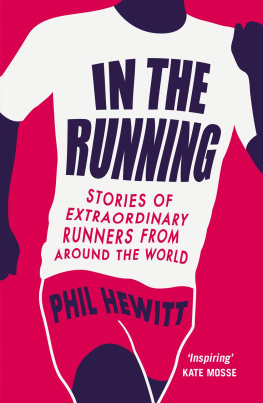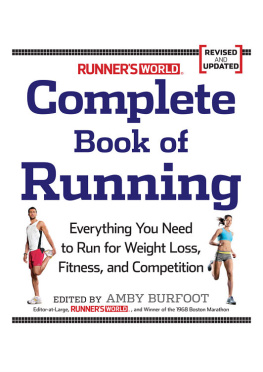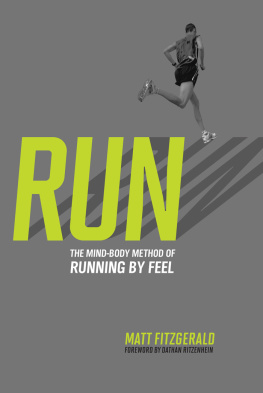

CONTENTS
THE MAN WHO TAUGHT ME EVERYTHING | AMBY BURFOOT
INTRODUCTION
O VER THE COURSE of his brilliant and prolific career writing about sports, the late George Plimpton developed his Small Ball Theory, which he describes in the introduction to The Norton Book of Sports, an anthology he edited in 1992. Plimpton found a correlation between the quality of writing about a particular sport and the size of the ball used to play it: the smaller the ball, the better the writing. You might think that carrying this theory to its logical conclusion would place stories about running at the top of the podiumno ball at all! This would be especially true if you knew that Plimpton, well-known for taking readers inside the most sacrosanct of worlds (by, among other things, going three rounds with light heavyweight Archie Moore and playing quarterback for the Detroit Lions), claimed to have gotten his start as a participatory journalist by seeing what it would be like to win the 1947 Boston Marathon.
I was prudent enough to enter the race a block and a half from the finish line, he said some years later in an interview. There was one person ahead of me. I put on a desperate sprint but still lost, indicative of my speed. But I was exhilarated in a curious way.
Alas, Plimptons appreciation for running, and for its literary potential, never really took off. Of the 70 fine pieces he collected in the 489-page Norton anthology, not one involved running. Nor is there a single running-related story among the 59 anthologized in The Best American Sports Writing of the Century, edited by David Halberstam and published in 1999. These two tomes explore baseball and football and golfballs of all sizesas well as boxing and horse racing and even frog jumping. But not one exemplary running story in 100 years? I know that runners have traditionally (and rather happily) trod around the periphery of the American mainstream, but something is wrong here. Even Red Smith, widely regarded as the greatest sportswriter who ever lived, wrote sparingly about running, explaining why in a 1981 New York Times column called The Mile Is a Mockery. If God had intended man to run, Smith wrote, he wouldve given him four legs, or at least made him late for a bus. To be sure, speed afoot might have been useful to some of the young ladies pursued by Jack the Ripper, but unnecessary running is a crime against nature. This goes for the joggers who clutter our country roads and infest our parks, and young men like Sebastian Coe and Steve Ovett who perform publicly in their underwear.
A crime against nature. Okay, then.
At least some exceptional books from the past five decades have emerged, despite this strange sportswriting bias: Alan Sillitoes The Loneliness of the LongDistance Runner; Roger Bannisters classic The Four-Minute Mile; the cult novel Once a Runner by John L. Parker Jr.; Dr. George Sheehans bestseller Running and Being; Jim Fixxs breakthrough call to arms, The Complete Book of Running; Bernd Heinrichs Why We Run. But when it comes to long-form magazine and newspaper writing, the storytelling promise of running seems to have eluded a couple generations of literary journalists.
This is especially odd considering that running is among the oldest sports known to man. The first Olympic Games, in 776 BC, featured just a single event: the stadion, a sprint from one end of the stadium in Olympia, Greece, to the other. And even though performance-enhancing drugs have tarnished running in recent years and cast many of its contemporary heroes into doubt, it remains a high-profile sport with sublime athletes and huge, world-class competitions. So all the elements are certainly in place for some good old-fashioned sportswriting.
But thats only the half of it, because we dont merely watch the elites run. We run ourselves, for all kinds of reasons. Running is often called the peoples sport, in part because its such a short leap from our regular lives. At any given moment, the only thing separating us from a run is a quick change of clothes. We can go out alone or with a group, any time of day, wherever we are. We dont need lessons or formal training or fancy equipment. This doesnt mean that running is easy. Its not, but the effort always pays off, in ways seen and unseen. For all these reasons, running contains more humanity than any other sport, in every sense of the wordmore people (tens of millions in America alone), more built-in joy and anguish, more depth, more soul. Theres even compelling evidence that running actually made us human in the first place. It was our ancestors ability to chase down their dinners over long distances on the African veldt, some scientists believe, that enabled them to survive and evolve. I say the following as a devout Red Sox fan and a former football player, but when was the last time you heard an evolutionary biologist postulate that hitting a curveball makes us human? Or throwing a nice, tight spiral? Or smacking a dimpled ball with a club before hopping in a motorized cart to race ahead and hit it again?
Heres something else that makes us human: telling stories. Its easy to imagine our ectomorphic ancestors sitting around a fire, telling their friends about finally running down that herd of wildebeestor at least painting the scene on the wall of their cave. Like twin strands of DNA, running and story telling are connected on a human, elemental level. Any run can be viewed as its own private drama with a beginning, a middle, and an end. For the vast majority of us, there is no stadium or crowd of cheering spectators. We generate our own progress according to our own definition of success. Time passes slowly, unless its one of those blessed days when it flies by. Were left with our thoughts and our labor. This sounds a lot like writing. And reading.
The storytelling possibilities extend from there, to runners themselves (a remarkable lot, by and large), the places running takes them (both geographical and psychological), and the life-changing potential of putting one foot in front of the other again and again (beating cancer, kicking the bottle, taming your demons ).
So thats why running lends itself to great writing and storytelling. This book is intended to demonstrate howand to level the playing field on the anthology front. I originally hoped it would be a survey of the best long-form narratives, profiles, and essays from the magazines beginning in 1966 to the present day, so I immersed myself anew in the RW archives, reading dozens of stories from the past four decades. But when the final selections were made, all but one of them had been published in the past seven years. To borrow a ball-sport metaphor, ambitious long-form feature writing just wasnt a club that Runners World had had in its bag for 30 years, or at least it wasnt a club that had been swung with regularity.
Were taking bigger cuts now. Yes, runners still come to the magazine for instruction and advice. But they also want to be moved and inspired. So at a time when long-form narrative journalism is disappearing from many magazines and newspapers, Runners World remains committed to telling great stories at the length they deserve, which often means 8,000 or 9,000 words. Those are the kinds of stories collected here. To land in these pages, they had to go long and deep, transcending running as mere sport in some way, connecting it to larger themes such as fame, faith, family, love, and even life and death.
Next page








